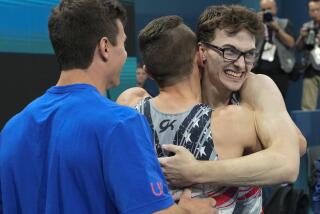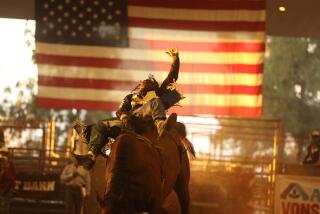Mutton bustin’: the Little League of rodeo country
SANTA FE, N.M. — It’s 30 seconds before his big rodeo ride, and Julian Apodaca looks like he wants to disappear under the wide brim of his white cowboy hat.
He’s staring down at his boots, tugging at his lower lip, rubbing at his teary eyes.
Julian’s father, a former junior bull-riding champion, has a hand on each of his 5-year-old son’s shoulders.
“It’s OK, hijo,” Vince Apodaca says as somebody plucks the hat off the boy’s head and replaces it with a helmet. “Cowboy up, OK? I don’t want no crying when you get on there.”
This is the world of a little-known but beloved rodeo event where kids a couple of years out of diapers ride sheep just like the big boys ride bulls. Suburban parents put their kids in Little League. In the country, where rodeo is king, parents sign up their kids for mutton bustin’.
In a flash, a rodeo hand lifts Julian from his father’s arms and swings him onto the back of an unhappy sheep, which is jerking around in a small pen. “I love you!” Vince calls out as the gate comes up.
The sheep shoots into the arena, and there’s Julian, clinging tightly to its neck. Suddenly the animal cuts right and Julian slips left, tumbling into the dirt. As if that wasn’t bad enough, the sheep kicks him with a hind hoof as it stumbles away.
There are gasps all around. Then Julian stands up, wobbles a bit, and grins.
Kids have probably been climbing on the backs of sheep for as long as there have been ranches. But it was in last 30 years or so that mutton bustin’ started appearing at rodeos in the West. Here at the 60th annual Rodeo de Santa Fe, which has held the event since the mid-1990s, the rules are pretty simple: If your child is between 4 and 8 years old and weighs less than 65 pounds, you can sign a liability waiver, pay 30 bucks, plop him on a sheep and tell him to hang on.
Twenty kids will participate tonight in two groups, one before the rodeo begins and the second as halftime entertainment. The ride rarely lasts longer than a few seconds (sheep may not buck, but they sure can wiggle), and every boy or girl walks away with a shiny silver belt buckle stamped “Champion.”
It’s not a competition, but don’t tell that to the parents, especially those who want their kids to grow up to be professional bull riders.
Observes Jamie Neal, who has organized the event for the last several years: “It can get intense.”
Stone T. Smith may only be 5 years old, but he’s got pedigree.
The sturdy blond comes from the best-known roping family in the Texas Panhandle. His father, Stran T. Smith, is a world-champion tie-down roper (he’ll be riding here later tonight), and the Smith clan has relatives in the ProRodeo Hall of Fame.
As his father prepares to compete, Stone’s older cousin Sawyer Vest frets over some bad news. The sign-up sheet for the next round of mutton bustin’ is full, and Stone might not be able to ride.
“I’m going to be so mad if he can’t rock it tonight,” says Vest, 20. “He’s never been that interested in rodeo, but today I finally convinced him to do it.”
Vest and Stone are standing next to the sheep pen, sizing up the animals. This flock -- which will be used for shearing, not eating -- comes from a spread up north, where the rancher lets the sheep’s wool grow long so the kids will have something to hold on to. Tonight it’s matted in long dreadlocks.
“All you got to do is bear-hug it,” Vest is telling Stone. “Just get a grip on ‘em.”
Stone, who seems more interested in fiddling with his sunglasses than discussing grip technique, soon wanders away to climb beneath the bleachers with another little boy.
Mutton bustin’ is the first notch in a cowboy’s belt, says Vest, who is slim and broad-jawed with curly, reddish-blond hair. As he talks, he hooks his thumbs behind his own big belt buckle, which he won a few years back at a calf-roping competition.
“This is where you start,” he says. “I always did sheep-riding. I have lots of mutton bustin’ buckles.”
Vest plays safety for the Texas Tech football team, so he doesn’t have much time for rodeos anymore. But he sure would be glad if Stone got into it.
That just might depend, Vest says, on whether Stone gets to ride tonight.
Up in the bleachers, Neilly Busch, 6, is squeezing at a dusty scrape on her forearm, trying to make it bleed.
“She’s a tough girl,” says her father, Rowlie Busch.
Neilly and her older brother, Ridgewalker, rode in the first round of mutton bustin’. (At 9, Ridgewalker is technically too old to ride. This is one of the little secrets of mutton bustin’ -- some kids who are too old or too heavy still end up on sheep.)
They both got bucked pretty quickly.
“The sheep was like, ‘Get off me!’ ” Neilly says. “He was kind of scary, but he was kind of cute.”
From his spot in the top row of the risers, Rowlie can look down on the staging area, where the bull riders are getting ready. They’re stretching out their hamstrings, wrapping tape tight around their hands, and throwing back cans of energy drink. A couple of them have knelt down in the dust to pray.
“Rodeo’s a dying thing,” says Busch, who lives in Santa Fe. “It’s good to come out here and see the real deal. These are real cowboys.”
The rodeo queen rides out, the national anthem is sung, and the announcer says he’s going to lead a prayer. Everybody stands up, places their hats over their hearts and closes their eyes.
When it’s over, the announcer calls out the words everybody’s been waiting for:
“Are you ready for rodeo on a Friday night?”
The crowd responds with a roar.
As the night wears on, rain clouds move in. The announcer breathlessly talks his way through the steer wrestling and saddle-bronc riding, and the crowd kicks back with popcorn, Indian tacos and Frito pies. For the uninitiated, the Frito pie is a favorite Southwestern snack of ground beef, chopped onions and loads of red and green and chiles piled on a bed of Fritos corn chips, sometimes served in the bag.
Dominick Lopez, 5, is clutching his tummy.
“I’ve got a stomachache,” he says.
“Those are butterflies,” says cousin Manuel Cavanaugh -- an old hand at mutton bustin’ at age 10.
His advice for his cousin, who is wearing child-sized silver chaps, and for his friend Maureen Martin, 8, another first-timer: “Just inhale and exhale.”
Manuel, who has ridden the woolly beasts five times, tells the kids that he hung on best when he gripped the sheep’s shoulders. But Maureen has a different technique in mind. “I’m gonna grab it around the waist,” she says.
Each kid wears a protective helmet, a vest, long pants and a long-sleeved shirt -- safety measures that were introduced a few years ago after one child who caught a hoof in the stomach had the air knocked out of him.
As for the sheep, which weigh about 70 to 100 pounds each, organizers say they have never been harmed. But animal rights groups -- frequent critics of rodeo sports -- have condemned mutton bustin’ as animal abuse. They’ve also called it child abuse.
At tonight’s rodeo, Maureen and Dominick’s names are called and their parents hand them up to the platform next to the bull chutes, which rodeo hands have stuffed with bawling sheep.
Neal, the organizer, is going from kid to kid, making sure each has the proper safety gear, when Sawyer Vest taps on her back.
“Excuse me, ma’am. You don’t happen to have an extra spot?” he asks. “Can we get Stone in? Stone Smith?”
She looks at him for a long second and then bends down to Stone.
“Are you sure you want to ride?” she asks. The boy shakes his head no and then buries his face in his cousin’s knees.
“Yes, he does,” Vest says. “He does. He’s been talking about it all day.”
Jamie looks again at Vest, who is nodding his head earnestly and patting Stone on the head.
“OK,” she says. “Get him ready.”
Big drops of monsoon rain are starting to fall, and the wind is picking up from the south. The kids are getting lowered down, one by one, onto the sheep.
“Dominick Lopez!” the announcer cries, and out sprints a sheep carrying Dominick, his chaps flapping. He’s so tiny and hangs on so well that the crowd of about 1,000 cheers him as loudly as they might a bull rider approaching his eighth second. When Dominick finally falls, he stands up right away and walks chin-up out of the arena.
“Maureen Martin!” the announcer calls out, and her sheep flies into the middle of the ring.
As the sheep circles back, Maureen is still on top, her arms clutched around its belly. Her technique pays off: She stays on 10 seconds, longer than anyone else.
Finally, it’s Stone’s turn.
He looks at the sheep he’s about to ride with quivering lips. Just before he gets lifted up, the rodeo hand stops him. “No spurs,” the man shouts. The spurs are stripped from the boots and Stone is plunked onto the sheep.
“This is us right here, big dog!” Sawyer calls out to Stone. “You got this.”
The gate comes up and the sheep streaks out. Almost immediately, Stone rolls off onto the ground. He sits up, lets out a mouthful of dusty spit and starts to cry.
Later, he poses for a photograph between his cousin and father, their hands on his shoulders. He’s beaming. So are his father and Vest.
Like every other mutton buster, he walks away with a belt buckle -- his first. The sheep are herded back to their pens for some feed and some peace. The bull riders fall to defeat or ride to glory.
And the kids go home, to grow a little taller, and maybe try again.
--



